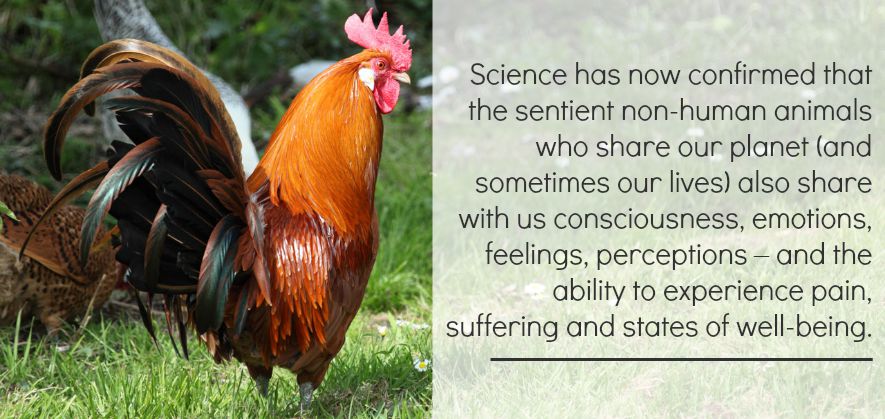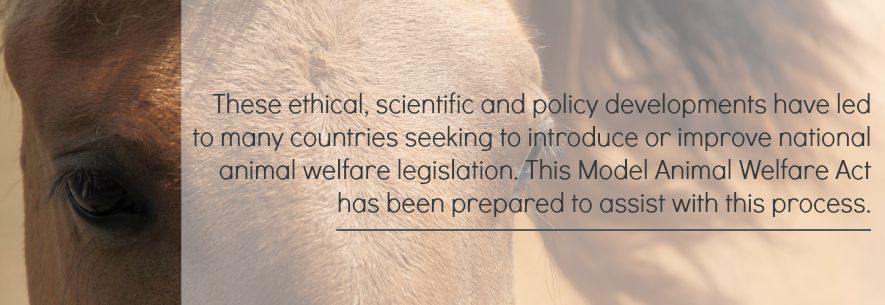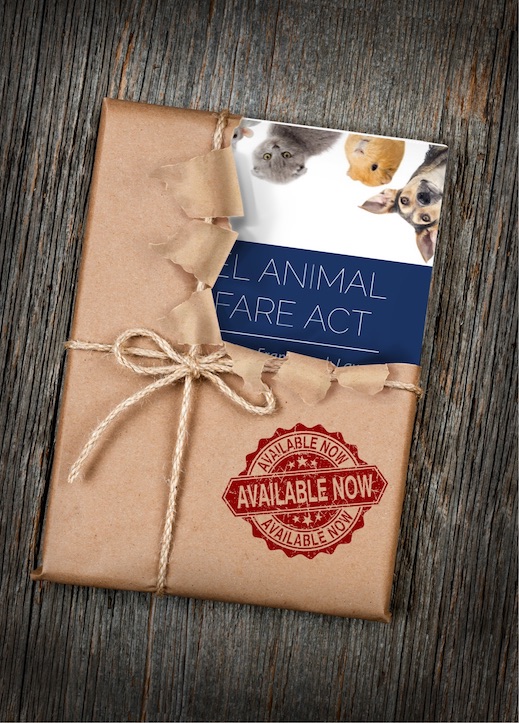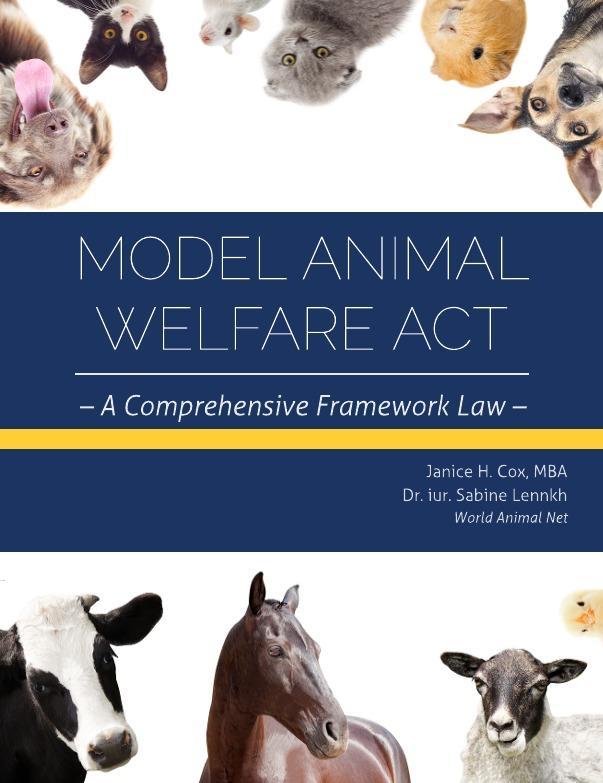
Developments in Animal Welfare and Science
Animal welfare is increasingly acknowledged as an issue of major ethical and practical importance. Science has now confirmed that the sentient non-human animals who share our planet (and sometimes our lives) also share with us consciousness, emotions, feelings, perceptions – and the ability to experience pain, suffering and states of well-being. They are not 'objects' or 'things', and have not been considered as such in this Model Animal Welfare Act (Model AWA). Just like us they have biologically-determined natures, instincts and needs which are important to them. This underlines the necessity to acknowledge each individual animal’s intrinsic value, and the fact that every single animal is not only worthy of respect and care, but also deserves to live a life that is meaningful without unnecessary human exploitation or interference.

Greater scientific knowledge and awareness have increased understanding of the importance of animal welfare; and this in turn has moved it from a marginal local or national concern to become an important regional and international policy issue. Animal welfare is now not only debated in regional and international policy forums, but is also covered by a fast-growing body of internationally and regionally accepted science-based policies, standards, conventions, treaties, regulations, directives and agreements.
Developments in Animal Welfare and International Policy
Today the World Organisation for Animal Health (still keeping its historical acronym of OIE: ‘Office International des Épizooties’) is the global standard setting body for animal welfare. At the request of its Member Countries, the OIE has been mandated to take the lead internationally on animal welfare and, as the international reference organisation for animal health, to elaborate recommendations and guidelines covering animal welfare. Animal Welfare was first identified as a priority for the OIE in the OIE Strategic Plan 2001 – 2005. Since May 2005, the World Assembly of OIE Delegates (representing each OIE Member Country and Territory) has adopted a body of international animal welfare standards, which are published in its Terrestrial Code and Aquatic Animal Health Standards Code (Aquatic Code). These standards are regularly updated to take account of latest scientific findings. The OIE continues to develop standards and recommendations in new areas of importance to animal welfare. These standards have been agreed by, and should be implemented by, each OIE Member Country. The OIE is also spearheading the formulation of Regional Animal Welfare Strategies (RAWS) for the progressive development of animal welfare across the various geographical regions, and these can include the introduction/improvement of legislation.
The Food and Agricultural Organisation of the United Nations (FAO) is also active in the field of animal welfare, having established a portal called the ‘Gateway to Animal Welfare’ on its Web Site, which contains a wide range of information on animal welfare subjects. It also conducts thematic discussions and expert consultations, and has worked on animal welfare legislation.
In terms of Regional Economic Communities (RECs), the European Union (EU) is the most progressive one in regard to including animal welfare in its sphere of policy work. Its activities in this area are based on the recognition that animals are sentient beings. An amendment to the constitutional basis of the EU, the Treaty of Lisbon, which came into effect on 1st December 2009, now includes this principle and made it a binding condition to ‘pay full regard to the welfare requirements of animals’ when ‘formulating and implementing’ policies in relevant areas (which are specified). This puts animal welfare on an equal footing with other key principles such as: gender equality, social protection, human health, combat of discrimination, sustainable development, consumer protection and data protection. The EU has developed an extensive body of animal welfare legislation which has improved animal welfare standards across the REC, and helped to harmonise standards within its ‘internal market’ (thus reducing competitive distortions). It is formulating a new EU Strategy for the ‘Protection and Welfare of Animals’, which will include the consolidation of its animal welfare framework, more action to support compliance (particularly in terms of enforcement; implementation systems; the development of best practice and expertise; and education and awareness) and international cooperation.
The EU has also contributed significantly to raising the profile and awareness of animal welfare at an international level – including through its collaboration with intergovernmental organisations such as the OIE and FAO; training and capacity building activities; and bilateral contacts (for example, including animal welfare in trade agreements with third countries).
Furthermore, these developments are not restricted to the ‘Global North’. For instance, policy commitments to animal welfare are now also being developed across Africa – by important bodies such as the African Union (AU-IBAR) and some African Regional Economic Communities, as well as individual countries.
The Need for This Model Animal Welfare Act
These ethical, scientific and policy developments have led to many countries seeking to introduce or improve national animal welfare legislation. This Model Animal Welfare Act has been prepared to assist with this process. It has been formulated using a comparative analysis of the best available legislative models, precedents and advice; taking into account international standards and rules, and current knowledge based on animal welfare science and practical experience. It has also undergone an extensive consultation and evaluation procedure by international experts and institutions, which raised a multitude of helpful concerns and suggestions, all of which have contributed to the development of a deeply considered and more rounded proposal.

The most advanced modern animal welfare laws go beyond the traditional ‘animal protection’ or ‘prevention of cruelty’ statutes (which focus on protecting animals against human cruelty, i.e. deal with preventing acts of commission, as opposed to also including acts of omission). They are, in principal, now designed to meet the following three main requirements: to promote animal welfare, to prevent animal cruelty and to minimise the suffering of animals.
Furthermore, contemporary animal welfare legislation combines three core obligations. These are addressed to
The population – The duty of care (thus fostering the keeper’s and handler’s sense of responsibility towards the animal and ensuring that hence not only commission but also omission is covered by the law);
The state – The duty to create awareness, to inform, to educate and to support all issues of animal welfare; and
The authorities– The duty to effectively enforce the laws.
Defining Animal Welfare
The concept of animal welfare is evolving over time in line with ethical, scientific and policy developments. It is now more complex and developed than in early days when it was considered only in relation to absence of cruelty or ‘unnecessary suffering’. Meanwhile it is generally defined using a number of concepts including: sentience; needs, interests and emotions; physical, mental and natural states (‘telos’); and the five freedoms. This Model Animal Welfare Act takes account of these contemporary concepts of animal welfare, and is predicated on the belief that animals should have a good quality of life (enjoying physical, mental and emotional well-being; including the ability to live meaningful and natural lives, where they are able to meet their species-specific and ethological needs and behaviours) and a humane death.
The definition of animal welfare currently used by the OIE is:
“Animal welfare means how an animal is coping with the conditions in which it lives. An animal is in a good state of welfare if (as indicated by scientific evidence) it is healthy, comfortable, well nourished, safe, able to express innate behaviour, and if it is not suffering from unpleasant states such as pain, fear, and distress.”
“Good animal welfare requires disease prevention and appropriate veterinary treatment, shelter, management and nutrition, humane handling and humane slaughter or killing. Animal welfare refers to the state of the animal; the treatment that an animal receives is covered by other terms such as animal care, animal husbandry, and humane treatment.”
The OIE has ‘Guiding Principles for Animal Welfare’, which were included in its Terrestrial Animal Health Code from 2004. These categorically state that: ‘The use of animals carries with it an ethical responsibility to ensure the welfare of such animals to the greatest extent practicable.’
The Five Freedoms
Also included amongst the OIE’s Guiding Principles are the internationally recognised ‘Five Freedoms’ which were originally published by the UK’s Farm Animal Welfare Council (FAWC) in 1979 (although they originated in the ‘Brambell Report’, which dated back to 1965), and have been adapted slightly since their formulation. These are as follows:
1. Freedom from Hunger and Thirst and Malnutrition – by ready access to fresh water and a diet to maintain full health and vigour;
2. Freedom from Fear and Distress – by ensuring conditions and treatment which avoid mental suffering;
3. Freedom from Physical and Thermal Discomfort – by providing a suitable environment including shelter and a comfortable resting area;
4. Freedom from Pain, Injury and Disease – by prevention or rapid diagnosis and treatment; and
5. Freedom to Express Normal Patterns of Behaviour – by providing sufficient space, proper facilities and company of the animal's own kind.
The ‘Five Freedoms’ provide valuable guidance on animal welfare needs; and they cover all three of the states identified above (physical, mental and natural states).
As a complement to the Five Freedoms, 12 criteria for the assessment of animal welfare have been identified by the Welfare Quality Project (WQP), a research partnership of scientists from Europe and Latin America funded by the European Commission. The WQP aims to develop a standardised system for assessing animal welfare – a system that would be implemented in Europe – and more generally to develop practical strategies and measures to improve animal welfare (Welfare Quality, 2009).
The 12 WQP criteria for the assessment of animal welfare are
1. Animals should not suffer from prolonged hunger, i.e. they should have a sufficient and appropriate diet.
2. Animals should not suffer from prolonged thirst, i.e. they should have a sufficient and accessible water supply.
3. Animals should have comfort around resting.
4. Animals should have thermal comfort, i.e. they should neither be too hot nor too cold.
5. Animals should have enough space to be able to move around freely.
6. Animals should be free of physical injuries.
7. Animals should be free of disease, i.e. farmers should maintain high standards of hygiene and care.
8. Animals should not suffer pain induced by inappropriate management, handling, slaughter or surgical procedures (e.g. castration, dehorning).
9. Animals should be able to express normal, non-harmful, social behaviours (e.g. grooming).
10. Animals should be able to express other normal behaviours, i.e. they should be able to express species-specific natural behaviours such as foraging.
11. Animals should be handled well in all situations, i.e. handlers should promote good human-animal relationships.
12. Negative emotions such as fear, distress, frustration or apathy should be avoided, whereas positive emotions such as security or contentment should be promoted.
The WQP criteria offer a useful framework for the development of legislation in line with international animal welfare principles. They have built on the Five Freedoms, developing more concrete and specific guidelines which may be more easily measured in practice (and particularly useful for legislative enforcement).
The 3Rs
The OIE’s Guiding Principles for Animal Welfare also include the internationally recognised ‘Three Rs’ (3Rs) which provide valuable guidance for the use of animals in science. These are as follows:
1. Replacement of animals with non-animal techniques,
2. Reduction in numbers of animals, and
3. Refinement of experimental methods.
However, these should, in principle, additionally be applied to all commercial uses of animals where there is any doubt that all the welfare needs of the animals can be met, in which case the wording would need to be amended appropriately.
Together these important principles contain the fundamental precepts of animal welfare and protection, and currently form the foundations of various animal welfare policies, including those of the European Union.
One of the ‘General Principles’ of the 2008 Policy of the World Society for the Protection of Animals (WSPA), now World Animal Protection, was: “WSPA believes that where the welfare of an animal under human control is in question, then the animal must be given the benefit of any doubt. Furthermore, the different purposes for which animals are used must be regularly re-evaluated.” This clearly promoted the ‘precautionary principle’ as regards any animal use. Furthermore, the Policy stated that "... where the needs of a species cannot be met, the species must not be kept by humans.”
Creation and Modification of Animal Protection Legislation
As regards primary legislation, a national framework Act is needed which establishes the ethical basis and firm guiding principles which would underpin all subsequent secondary legislation, codes of conduct and guidance. In concrete terms, regulations should be used as the main means of placing these principles into practice for each specific area of animal use/concern. These could be supplemented, as necessary, by codes of conduct and guidance (in particular where extensive specialist input and/or further detailed guidance and interpretation for users are needed).
This approach will facilitate the inclusion of future international animal welfare standards (and subsequent improvements) as well as of additional areas where the welfare of animals needs to be re-codified.
It is important that these provisions do not remain static and fixed in time, but continue to be developed in response to the rapidly-occurring changes in our state of knowledge (including scientific progress) and evolving values on animal welfare.
The general principles reflected in the Animal Welfare Act should apply to national policy ‘across the board’, and so also be reverberated in other national policies which deal with issues affecting animals and their welfare.
There are also general requirements in relation to modern animal welfare legislation: This should be comprehensive and precise as well as clearly worded, progressive, powerful and forward-looking, efficacious and executable as well as adapted to the particular needs and challenges of the country in question. Dedication and commitment are certainly key factors which have to be firmly embedded in the new legislation as well, by manifesting an open-minded, ethically founded, compassionate and progressive approach to the subject along with the willingness of a government and a nation to accept their duties and responsibilities to their fellow beings.
Furthermore, the Animal Welfare Act should go beyond practical measures intended to improve the welfare of animals, and aim to develop a deeper and broader based humane ethic as well as a ‘culture of caring’ in society. This will be beneficial for society, people and animals.




